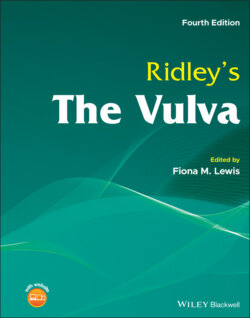Читать книгу Ridley's The Vulva - Группа авторов - Страница 35
Foetal androgen excess
ОглавлениеFoetal androgen excess is generally due to forms of CAH. The most common disorder in this group is virilising CAH. This is usually an autosomal recessive inherited condition due to mutations in the CYP21A2 gene, leading to reduced 21‐hydroxylase activity. This in turn causes reduced levels of cortisol and aldosterone, a rise in ACTH, adrenal hyperplasia, and consequently high levels of 17‐hydroxyprogesterone and testosterone. As salt wasting and adrenal insufficiency in the neonatal period are serious complications, screening programmes are in place, and most cases are diagnosed in this period.
Typical CAH results in clitoromegaly, fusion of the labia majora, and a single perineal opening dividing proximally into the urethra and vagina. Expert surgery is required, but the timing of this can be difficult. The aim of surgical intervention is to bring the vagina to normal position on the perineum, to separate the distal vagina from the urethra, and to ensure an adequate vaginal introitus [31]. It is important to preserve clitoral innervation if clitoromegaly is to be reduced surgically. However, clitoromegaly can improve with time, so surgery for this can be delayed. The main complications of these procedures are incontinence and enuresis, wound breakdown, infection, and vaginal stenosis [32]. With follow‐up, most patients are sexually active but report reduced sensation.
Atypical presentations may not be diagnosed until adolescence or adulthood, and features can overlap with those of polycystic ovarian syndrome. Patients with CAH are at increased risk of diabetes, thromboembolic disease, and thyroid disorders [33].
There are other autosomal recessive forms of CAH giving rise to disorders of steroidogenesis. These include deficiencies of 11‐ß‐hydroxylase deficiency (CYP11B1 mutation), 3‐ ß‐hydroxysteroid dehydrogenase (HSD3B2 mutation), P450 oxidoreductase (POR mutation), aromatase (CYP19A1 mutation), and 17‐hydroxysteroid dehydrogenase. Deficiencies of 3‐ ß‐hydroxysteroid dehydrogenase and 17‐hydroxysteroid dehydrogenase reduce cortisol production and also impair the synthesis of sex steroids by the gonads and adrenals. With 3‐ ß‐hydroxysteroid deficiency, the only androgen synthesised is dehydroepiandrosterone (DHEA), which is relatively weak, and females with this deficiency are less virilised than those with the 21‐ or 11‐ß ‐hydroxylase deficient forms of CAH. With reduced levels of 17‐hydroxysteroid dehydrogenase, the female external genitalia are normal at birth, but no secondary sexual development occurs at puberty.
